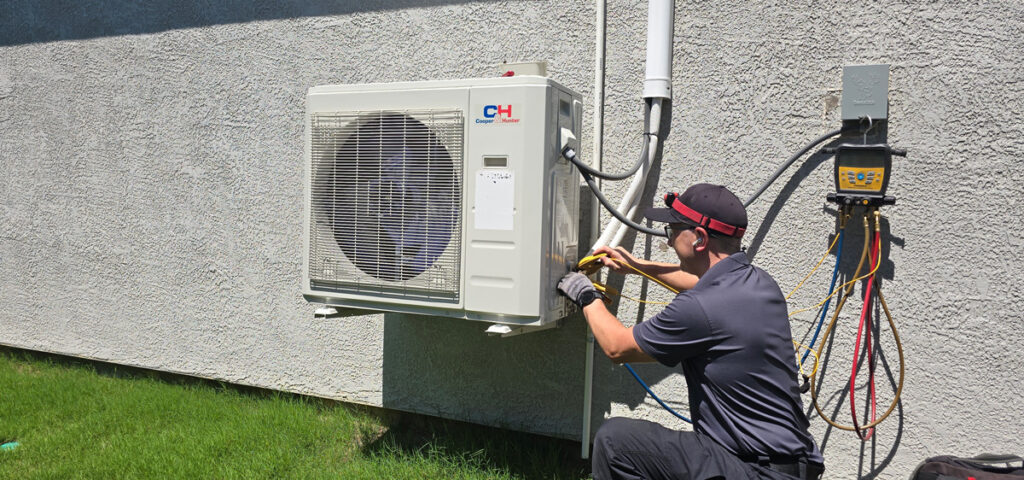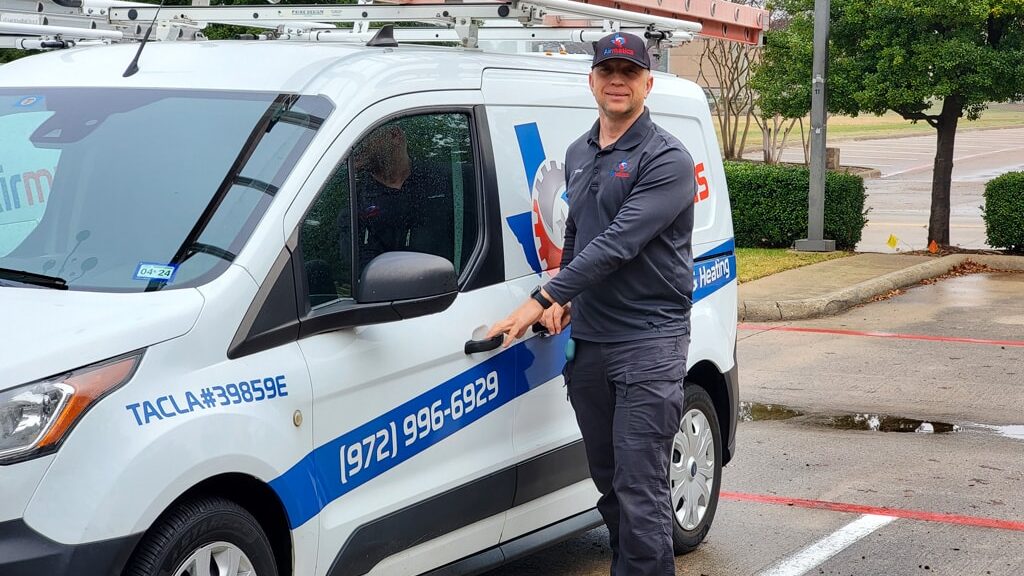An air conditioning system relies on working AC drain lines to remove excess moisture and condensation from the evaporator coil.
A clogged drain line can happen when debris builds up and water backs up causing damage and mold growth. If water sits in the AC drain lines for too long, it can cause more problems. A clogged AC drain line can also cause water to back up and increase humidity indoors.
Regular maintenance of the AC drain line is essential for preventing clogs and ensuring the air conditioning system operates smoothly. Moisture can also cause rust on system components and shorten the life of the AC unit.
The AC drain pan and condensate drain line work together to remove excess water from the system.
A clogged AC drain line can be diagnosed by looking for standing water, excess water, or moisture around the air conditioner.
Causes of Clogs
- Debris, dirt and objects can get stuck in the drain pipe or pipes and cause a clog.
- Mold and bacteria can grow in drains, causing blockages and clogs.
- A blocked AC drain line can be caused by algae, mildew or other debris in the line.
- Using harsh chemicals or improper cleaning methods can damage the drain line and cause a blockage in the line.
- A clogged AC drain line can also be caused by a blockage in the condensate line or drain pan.
A blocked drain line can cause system failure, water damage, or even mold growth, so you need to address these issues quickly. If an AC drain line becomes blocked, it can damage floors and drywall from overflow.
How to Identify Clogs
- Signs of a clogged AC drain line are water leaks, excess moisture and mold growth around the air conditioner. AC drain lines are prone to clogging, so you need to check them regularly.
- A blocked drain line can cause the air conditioning system to malfunction or shut down.
- If you see standing water, that means water is trapped in the line, which is a sign of a clog.
- Check the drain line for blockages, kinks or damage. Make sure to check near the indoor coil for moisture or clogs as well. Use a flashlight to inspect the drain line to find blockages or debris.
- A clogged AC drain line can also cause a musty or moldy smell to come from the air conditioner.
What Happens if I Ignore a Clogged AC Drain
Ignoring a clogged AC drain can have serious consequences for your air conditioning system and home. When a drain line gets blocked, excess water can accumulate in the drain pan and eventually overflow and cause water damage to floors, walls and ceilings. That standing water is a breeding ground for mold and bacteria, which can cause odors, health issues and further damage to your AC unit.
A clogged drain line can also cause your air conditioning system to work less efficiently, reducing its cooling power and potentially shutting down the system if not addressed. Water in the drain pan or line can corrode components and result in costly repairs or even a full system replacement. Over time, the mold and bacteria in the AC drain can exacerbate allergies and respiratory conditions, making indoor air quality a concern.
To avoid these issues you need to fix the clogged drain line quickly and maintain your AC system regularly. Addressing problems early will protect your home from water damage, keep your air conditioning running smoothly and ensure a healthy and comfortable environment for everyone.
Safety Precautions Before You Start
Before you start to unclog a clogged AC drain line, you need to prioritize safety to avoid injury and damage to your air conditioning system. Turn off the air conditioner at the thermostat and disconnect power to the AC unit to prevent electrical shock while working on the drain line.
Wear gloves, safety glasses and a face mask to protect yourself from bacteria, mold and debris that may be in the drain or around the AC drain line. Make sure the area around your AC unit is clear of clutter and tripping hazards to have a safe workspace for the repair.
If you encounter stubborn clogs, excessive mold or are unsure of any step, don’t hesitate to call a professional HVAC technician. Taking these precautions will help you safely unclog the drain line and protect yourself and your air conditioning system from further damage.
Book Your AC Diagnostics in Plano or Nearby
Our professional air conditioner service maintenance responds quickly, provides safety and access to advanced tools, equipment, and expertise. Call us and we will restore your comfort!
Plano, Frisco, Allen, McKinney, Southlake, Grapevine, Dallas, Lewisville, Irving, Carrollton
CALL US TODAY FOR AC TUNE UP
Tools and Materials Needed
Having the right tools and materials is key to unclogging an AC drain line and keeping your air conditioning system running smoothly. For most DIY methods, you’ll need:
- Plunger and bucket: For dislodging minor clogs and catching water that may drain out during the process.
- Wet/dry vacuum (shop vac) and hose attachment: For sucking out debris and water from the drain line, especially for stubborn clogs.
- White vinegar or diluted bleach, a funnel, and a bucket: Pouring vinegar or diluted bleach through the drain line helps break down buildup and kill bacteria. Use a funnel for easy pouring and a bucket to catch any runoff.
- Wire brush: For scrubbing the inside of the drain line and removing tough debris or algae.
- Garden hose: For flushing the drain line with water pressure to clear out blockages.
- Snake tool: For reaching deep into the drain line to break up and remove clogs.
- Compressed air: For blowing air through the line to dislodge stubborn debris and restore flow.
Having these tools before you start will make the unclogging process smoother and more efficient. Regularly inspecting and maintaining your AC drain line with these materials will prevent future clogs and keep your HVAC system running cool and comfortable in your home.
DIY Solutions
- Remove the cap from the drain line to access the pipe. After maintenance, reseal it with a proper seal to prevent debris from entering.
- Using a plunger or inserting a snake into the drain line is a common method to unclog blockages. Push the snake in until you feel resistance, then rotate and use the other end to dislodge and remove debris. This unclogging method is good for stubborn clogs.
- Pour a solution of vinegar or diluted bleach down the drain line as another method to break down debris and kill bacteria. Pour the solution slowly to ensure it reaches the blockage. If you use a chemical drain cleaner, it may need to stay in the drain line for several hours to break down tough clogs.
- To flush the drain line, run water through it with enough water pressure to push out debris. You can also use a garden hose to run water and use water pressure to dislodge obstructions. Using compressed air to blow air through the drain line is another method. Blow air into the pipe to clear out blockages and restore flow.
- Remove any visible debris or blockages from the drain line to restore flow and is part of the unclogging process.
- Using a wire brush to clean the drain line is another way to remove buildup or debris.
Professional Solutions for Stubborn Clogs
- Call a professional HVAC technician to diagnose and repair the clog if it’s stubborn. As part of regular maintenance, they can also service your furnace to ensure indoor comfort.
- Use specialized equipment, such as a shop vac or plumbing snake, to remove tough clogs.
- Replace the drain line or condensate pan if the clog is severe or caused by damage.
- Use high-pressure air or chemical cleaners to break down tough blockages.
- A professional technician can also identify and fix any underlying issues that may be causing the clog.

Preventing Future Clogs
- Regularly clean and maintain the drain line to prevent clogs.
- Check the drain line for blockages or damage to identify potential issues before they become major problems.
- Use a drain line cleaner or maintenance product to keep the line free of debris and buildup.
- Avoid using harsh chemicals or improper cleaning methods to prevent damage to the drain line.
- Schedule regular maintenance with a professional HVAC technician to keep the air conditioning system running efficiently and prevent clogs.
Call Now for AC Service! We’ll Restore Your Comfort!
Maintenance and Repair
Regular maintenance is key to keeping your air conditioning system running smoothly and preventing a clogged drain line. Check the drain line periodically for signs of clogging or debris buildup. Keeping the drain line clean is crucial – pouring a solution of diluted bleach or vinegar down the line every few months will kill bacteria and break down algae before it causes a blockage. For more thorough cleaning, use a wire brush or snake to clear out any stubborn debris that may be stuck to the inside of the drain. Pouring bleach down the drain line monthly will keep it clog-free.
If you see standing water around your AC unit or in the drain pan, act fast to prevent damage to your system. Use a vacuum hose or shop vac to remove water and suck out any blockages from the drain line. Compressed air can also be used to blow out debris and restore flow. Always keep the line clean and clear of obstructions to prevent clogs from forming in the first place.
If the clog persists or the drain line is damaged it may need to be replaced. For these repairs call a professional to do the job right and safely. By being proactive with regular cleaning and prompt repairs you can protect your air conditioning system from clogging and keep your home cool and comfortable.
Conclusion and Next Steps
Clogged drain lines are a common problem that can cause big issues for your air conditioning system, including reduced cooling, water leaks and mold growth. But with regular maintenance and the right solutions, you can prevent most clogs and keep your AC running at its best. Make it a habit to inspect and clean your drain line using methods like flushing with a hose, applying diluted bleach or vinegar and clearing debris with a vacuum hose or compressed air.
If you do get a clog, address it right away using proven methods to break up and remove the blockage. Don’t wait to call a professional if the clog is severe or if you see signs of mold or water damage. To further protect your system, consider installing a p-trap to catch debris, running water through the drain lines regularly, and using products to prevent mold and mildew buildup.
Take these proactive steps to extend the life of your air conditioning system, prevent costly repairs and keep your home cool and comfortable. As a next step schedule regular maintenance with a qualified technician, buy a drain line cleaning kit and explore other solutions to keep your drain lines clear. By being vigilant and maintaining your AC system you can avoid the headaches of a clogged drain and enjoy cool air for years to come.
Ready to restore peace and efficiency?
Book your AC check-up today and get back to cool, quiet comfort.
